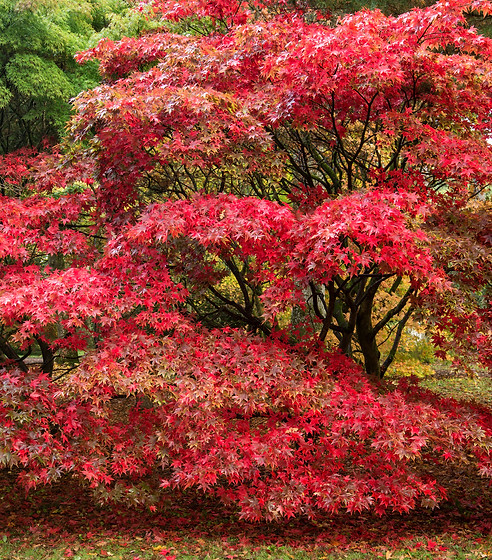Jamestown Tree
23 & 24. Japanese Maple - Acer palmatum


Known for its breathtaking beauty, the Japanese maple is a relatively small tree, widely planted for its leaf shape and fall color. Its leaves have a distinctive look, with five to nine deep lobes, often with serrated edges. Some Japanese maple cultivars (of which there are over 1,000) are green, others quite red, but they all put on a fall show. Typically, the branching habit is layered, a lot like a dogwood, and its silhouette adds beauty to the winter garden. Some varieties are more shrub-like, some are such a deep red that they appear purple, and some have very twisted branches that create a billowy mound of color.
These two Japanese maples are both Champion trees. Note the difference in the color and branching habit.
25. Japanese Cherry - Prunus serrulata

Also known as an ornamental cherry or Japanese flowering cherry, this tree typically grows about 50 feet high and is relatively short-lived. It produces single to semi-double pink flowers in spring and has spectacular fall foliage ranging from bronze to red. The bark is brown-pink with horizontal banding. When leaves first appear in spring they are bronze, but change to bright green within a few days.
The Japanese cherry was introduced from Japan to Europe just before World War I and is now commonly used in parks and municipal plantings across the United States. Fruit is not produced on this ornamental.
26. Tulip Tree - Liriodendron tulipifera


Also known as a yellow poplar (though it is not a poplar but a magnolia), this US native tree is one of the tallest eastern hardwoods, often reaching more than 100 feet. Tulip trees have a straight trunk, narrow crown and large, showy yellow flowers that resemble tulips. Another great unique identifier of tulip trees are its leaves, which resemble a goose's footprint.
Tulip tree flowers are often overlooked because they are so high in the air, but hummingbirds as well as many species of bees love the nectar. It is believed that one tulip tree can produce more nectar than several acres of clover. The tulip poplar is also the only host plant for the caterpillars of the tuliptree silkmoth and one of the host plants for tiger swallowtail caterpillars . Tulip trees are fast growing, provide great shade and are a nesting haven for many different songbirds.
27. Pagoda Tree - Styphnolobium japonicum

The deciduous Japanese pagoda tree is easily identified by its fragrant flower clusters in late summer, followed by seed pods which look like pearls on a string. Despite its name, it is actually native to China, Korea and Vietnam. It is also known as the Chinese Scholar Tree.
The Japanese pagoda tree has a rounded crown habit with compound ovate leaves. Seven to seventeen leaflets appear on each branch. The flowers are whitish yellow with five petals and are bunched into clusters. The seed pods are toxic to people. Typically, this tree reaches 60-75' at maturity and grows at a moderate rate.

28. European Larch - Larix decidua


The European larch is a deciduous, cone-bearing tree with needles. The needles start off as lime green in the spring, turn dark green in the summer, and finally turn yellow before they drop in the fall. The European larch is a fast-growing yet long-lived tree, with some reportedly as old as 750 years. It grows to about 130' tall.
The European larch flowers in the spring before the needles first emerge. The female flowers are purple-pink and develop into an immature cone. Cones take two years to fully mature.